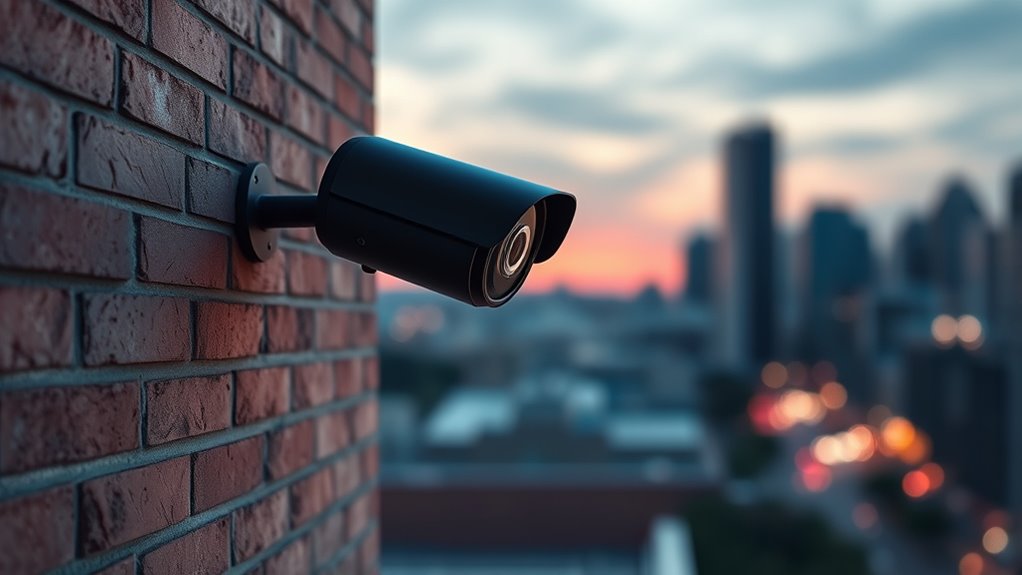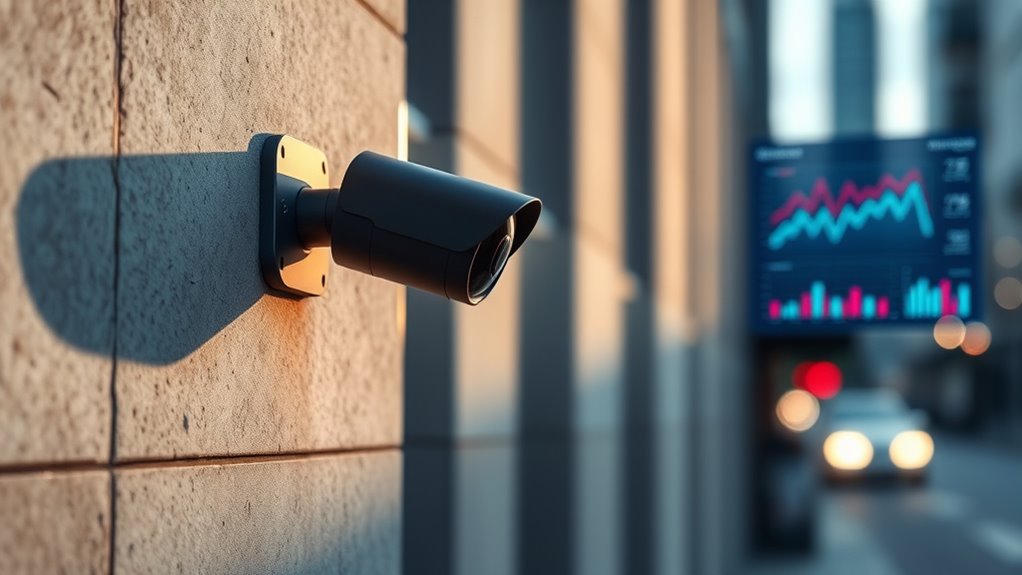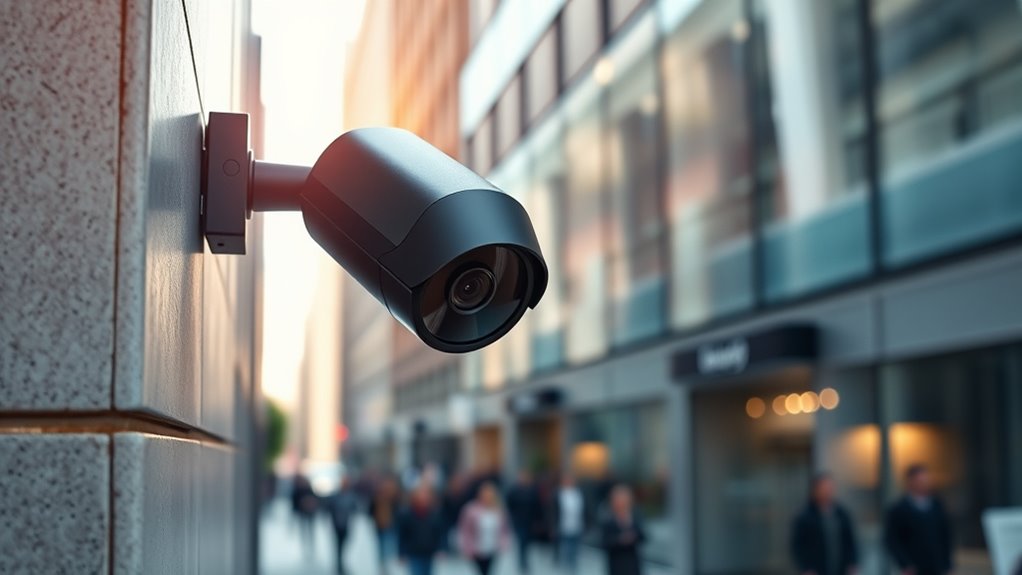Edge AI cameras offer a privacy-first security solution by processing data locally on the device, reducing reliance on cloud storage and minimizing data transmission. They include features like encryption, data localization, and event-driven alerts to safeguard personal information. Plus, they enhance security with device hardening and secure updates. These advancements ensure your data stays safe and private. Keep exploring to discover how future trends will further strengthen privacy and security with edge AI technology.
Key Takeaways
- Edge AI cameras process data locally, reducing cloud reliance and minimizing privacy risks.
- They employ encryption and data minimization techniques to protect personal information.
- Local processing ensures real-time security responses with low latency and high data control.
- Devices are secured with robust hardware, firmware updates, and access controls to prevent tampering.
- Privacy-preserving AI methods like federated learning and differential privacy enhance data security.
How Edge AI Cameras Enhance Privacy and Security

Edge AI cameras markedly boost privacy and security by processing data locally instead of relying on cloud storage. This setup reduces the need to transmit sensitive information over the internet, lowering interception risks. By handling data on the device, these cameras limit the impact of cyberattacks to a single point, making breaches less widespread. They also enable faster responses due to reduced latency, which is critical for security and surveillance. If a device is compromised, data breach effects stay localized, offering better containment. Additionally, local processing minimizes network load and reduces reliance on cloud infrastructure, cutting ongoing costs. Using dedicated hardware components ensures optimal performance and reliability. Incorporating edge computing principles further enhances data security and operational efficiency. These features are especially vital in privacy-sensitive environments, where safeguarding personal data is paramount. Implementing robust encryption protocols can further protect data during local processing and storage. Furthermore, the use of advanced authentication methods helps prevent unauthorized access to the devices and data. Overall, these features enable safer, more responsive security systems that prioritize protecting personal data while maintaining operational efficiency.
Key Privacy Features That Protect Personal Data

Protecting personal data is a top priority when deploying AI cameras at the edge, and several key privacy features help guarantee this. Data localization ensures processing occurs on the device, reducing transmission of sensitive information. Limited data retention means only necessary data is stored, lowering breach risks. Event-driven transmission sends only relevant alerts, not raw footage. Local analysis allows you to process video and audio on-site, sharing only non-sensitive results. Encryption at rest and in transit protects data from unauthorized access. Techniques like anonymization, masking, and pseudonymization safeguard identities. Privacy-preserving AI methods, such as federated learning and differential privacy, further enhance data security. Cookies and user consent ensure compliance with privacy regulations and foster trust. Implementing secure data management practices is essential to maintaining user confidence and adhering to legal standards. Establishing robust access controls helps prevent unauthorized personnel from accessing sensitive information. Additionally, adopting privacy impact assessments can help identify potential vulnerabilities and ensure comprehensive data protection strategies.
Technical Benefits of Local Data Processing

Processing data locally offers significant technical advantages by streamlining operations and enhancing performance. By processing data on the device, you drastically cut down the amount of data sent to cloud servers, which optimizes network bandwidth and reduces congestion. This lowers data transfer costs and minimizes exposure to network vulnerabilities. Local processing also reduces latency, enabling real-time responses crucial for applications like security monitoring or autonomous systems. With edge devices operating independently of internet connectivity, you guarantee high availability, even in remote or disrupted environments. Additionally, on-device learning allows your systems to adapt without relying on cloud updates, fostering smarter and more autonomous operations. Moreover, understanding relationships – personality test can help in designing more intuitive and user-centric security features. Incorporating local data processing can also improve overall system resilience against cyber threats by minimizing data exposure. By leveraging AI chip developments, you can further boost processing speeds and energy efficiency, making your solutions more scalable and sustainable. Overall, local data processing boosts efficiency, reliability, and cost-effectiveness—making your security solutions more resilient and responsive.
Mitigating Risks: Ensuring Device and Data Security

Ensuring device and data security is essential as the decentralized nature of AI cameras inherently broadens the attack surface. You must harden devices with robust security features, keep firmware updated, and protect physical access to prevent tampering. Encryption of data and communications is imperative to guard against interception and eavesdropping, while secure hardware minimizes risks of firmware manipulation. For data protection, minimize processed information, enforce strict access controls, and encrypt data at rest and in transit. Implement anonymization when possible, and maintain audit trails to detect breaches. To prevent model tampering, regularly verify AI model integrity, secure update processes, and monitor AI outputs for anomalies. Designing secure communication protocols, using strong authentication, and conducting regular security audits are critical steps to mitigate risks effectively. Additionally, integrating security best practices during deployment can further enhance overall protection. Environmental considerations such as minimizing impact on local ecosystems can also be integrated into security planning to promote sustainable practices. Incorporating cybersecurity frameworks can help establish comprehensive security measures tailored to AI camera deployments. Additionally, understanding AI vulnerabilities is key to developing comprehensive defenses against emerging threats.
Future Trends in Privacy-Focused Edge AI Security

As edge AI continues to evolve, advancements in privacy-preserving technologies are shaping a more secure and trustworthy landscape. You’ll see increased integration of differential privacy, ensuring individual data remains protected while enabling meaningful analysis. Homomorphic encryption allows processing encrypted data directly on devices, supporting secure local collaboration. Federated learning lets devices train models collectively without sharing raw data, reducing privacy risks. Lightweight encryption tailored for resource-limited devices balances security with performance. Hardware-accelerated security features enhance encryption without straining resources. Data minimization and local processing trends keep sensitive data on devices, cutting risks of interception. Additionally, implementing secure hardware modules can further bolster encryption and overall device security. Event-triggered recording and bandwidth controls limit data exposure. These innovations, driven by regulations and adaptive security architectures, create a future where privacy and security coexist seamlessly in edge AI cameras.
Frequently Asked Questions
How Do Edge AI Cameras Handle Software Updates Securely?
You handle software updates securely by using over-the-air updates with encryption to safeguard data during transit. You verify each update with cryptographic signatures and checksums to ensure integrity. Additionally, you rely on secure boot processes and trusted execution environments to prevent unauthorized changes. Regular update checks, rollback options, and strict access controls help you maintain operational security and reliability throughout the update process.
What Are Common Vulnerabilities in Edge AI Camera Hardware?
You should know that hardware in edge AI cameras often faces vulnerabilities like side-channel attacks on GPUs and NPUs, firmware flaws allowing malicious code, and risks from physical tampering. Memory bugs can lead to privilege escalation, and the absence of hardware security features makes them easier targets. Physical access, insecure updates, and inconsistent security measures across devices also heighten the risk, compromising both security and privacy.
Can Edge AI Cameras Operate Effectively in Low-Light Conditions?
In a city park at night, you notice how well an edge AI camera captures clear images despite low light. These cameras use large pixels and sensitive sensors to gather more photons, boosting image quality. They also incorporate AI to adjust settings dynamically, and infrared illumination for total darkness. With weather-resistant design and environmental adaptations, you can trust these cameras to operate effectively in low-light conditions, ensuring reliable security around the clock.
How Do They Integrate With Existing Security Infrastructure?
You can easily integrate edge AI cameras with your current security setup. They use standard protocols like ONVIF or RTSP, making them compatible with existing DVRs, NVRs, and VMS platforms. Wireless and wired options give you deployment flexibility. Local processing reduces network load, while APIs and SDKs allow custom integration. These cameras work alongside your current infrastructure, supporting gradual upgrades and ensuring seamless operation without major system overhauls.
What Are the Costs Associated With Deploying Privacy-First Edge AI Cameras?
Ever wondered what it costs to deploy privacy-first edge AI cameras? You’ll face expenses for hardware, like cameras and sensors, which can cost a few hundred dollars each, plus software licensing and ongoing storage fees. Deployment involves installation and integration, often leading to overruns. Plus, compliance and operational costs add up to guarantee data privacy and security. Are you ready to balance these costs with the benefits of enhanced security?
Conclusion
By choosing edge AI cameras, you prioritize privacy, enhance security, and gain control. You keep data local, reduce risks, and stay ahead of threats. You protect personal information, prevent breaches, and build trust. You embrace technology that’s smarter, safer, and more respectful of your privacy. You guarantee your security solutions are not just effective but also privacy-first. With edge AI cameras, you create a safer space, a more private environment, and a future you can trust.









